The History of the Camping Chair
What is a camping chair?
The best definition we could come up with is a collapsible, foldable or inflatible seat with backrest which you can use in various outdoor settings. There are many kinds of chairs which can be called 'camping chair' which differ greatly in size and style. The only common characteristic to all camping chairs is that they can be made smaller for the purpose of transportation. These chairs are generally meant to be used outdoors, in gardens, parks, countryside, beaches or in tents. The North Americans distinguish between backpacking chairs and camping chairs. In the UK 'backpacking chair' is not a frequently used term. We will include cover all foldable or packable outdoor chairs here.
Have you ever pondered the humble origins of the camping chair you are sitting on?
We are going to take on a journey from ancient sitting furniture to modern camping chair based on designs of early stools.
Until late 19th century the chair designs we feature were not developed for camping as such. Most of them were made for use during military campaigns as well as being used as garden chairs or inside homes for sedentary tasks.
The oldest known folding stool was created in Mesopotamia, which is modern-day Iraq, some 4500 years ago.
500 years later this stool was found to have been used by the Egyptians: a few fold up stools were discovered in Tutankhamun’s tomb by archaeologists.

These stools were made from two square-shaped wooden frames that were connected in the middle forming an X structure. Tutankhamun’s ceremonial throne, which was also found in the tomb, is the oldest ancient folding chair with backrest we found. Egyptian folding stools contained stretcher fabric or leather to sit on; todays version consists of a foldable aluminium frame with polyester fabric stretchers. Egyptian style folding stools were also used 3000 years ago in territories where Germany and Denmark now are.

Ancient Greeks borrowed many furniture designs from the Egyptians, including the folding stools. The Greeks, who had more timber available to experiment with, redesigned the Egyptian stool naming their version Diphros (stool) Okladias (Oikos meant home and family in ancient Greek). This suggests that the stool was often used at home for sedentary tasks or as general mobile furniture. Most surviving Diphros Okladias are ornamental with the stool legs often resembling animal legs, like the one below.

The Greeks are credited with creating a first three-legged stool. Whilst they had highly sophisticated back chair designs (with backs) for use indoors, it appears that Diphros Okladias were never updated to a chair with back support.
Oh, those Romans... What have they ever done for us? Well, apart from viaducts, concrete, sanitation, and other unimportant things, they were the first known nation to create foldable metal stools.

Advances in metal technology meant that metal fold-up chairs could take up less space and could be used in wet conditions for longer periods of time compared to the wooden options. These chairs are thought to have been used by the officers of the Roman army in the 4th and 5th centuries AD.
What happened next? A few hundred years later Vikings created a bog chair (8th to 9th century), also known as a Viking chair or Stargazer chair. This chair consists of two planks of wood put together in an X form.

These folding chairs (probably taken by the Vikings on their sea voyages) had a reclined angle that was more suitable for relaxation and was less for use during sedentary tasks, such as craftwork or knitting.
During the medieval period, the scissors chairs gained popularity. These chairs were more elaborated versions of the folding stools, including back support and armrests.

The seating area could be made out of wood, fabric, or a leather stretcher with sheepskin or a pillow placed on top of the wood-only version to make it softer. This chair was often used during military campaigns, in churches, and the sedentary craftsmen, such as weavers. It then gained popularity as a garden chair in the 18th-19th century. It was one of predecessors of today's camping chairs.
Joseph Beverley Fenby was a British inventor who, amongst other things, invented a foldable chair that goes by the name of the Fenby chair but became widely known in Europe as an officer’s chair or “Campaign Chair”. He designed in 1855 and patented only as late as 1881. It was manufactured by an Italian company in Tripoli, Libyaunder new name Tripolina. The Fenby's design uses hinge mechanisms to create a chair that can be folded in seconds with the fabric attached to the wooden structure in four of its corners. Nigor Flycatcher and Snow Peak Take Bamboo Long Chair are slightly modified versions of the Fenby Chair.

Theodore Roosevelt in Safari camp in Tanzania sitting on a Fenby chair
Have you ever been to an event that has a zillion unfolded chairs? The folding chair which is so widely used today was first patented in the USA by John Cram in 1855. There have been many updated designs since but the main principles have remained the same: in some, chair parts only change their angle when the chairs are folded, in others, parts slide when the chair is folded or unfolded.

Many modern camping chair designs have been based on the same folding principles. If we look at the Outwell Kenai chair, for example; it has armrests but unfolds and folds using the same mechanical principles as John Cram's original design.
In Western societies camping as a pastime only became popular among large parts of society in the late 19th century. Dwellers of increasingly industrialised towns began using expanding train infrastructure to visit the seaside and countryside during at weekends. Garden chairs travel chairs, military chairs were all used as camping furniture.New designs had to emerge to satisfy the increasing 'weekender' demand.
The deckchair design is often attributed to Cram's 1855 patent, used during the American Civil War and marketed in Britain as Yankee Hammock Chairs. In 1886 the design was improved by John Thomas Moore resulting in the deckchair design we know today. Nowadays it is a popular choice as a garden chair as well as being rentable in parks or the beach.

Deck chairs were used during tent camping in the late Victorian era
In the late19th century, Anderson's Safari Chairs gained popularity. Modelled on the Egyptian/ Etruscan folding stool but with an added backrest, these chairs were used in expeditions and various military campaigns as well as for general garden and camping use. This classic design is most familiar to us today as a the director's chair in the film industry.
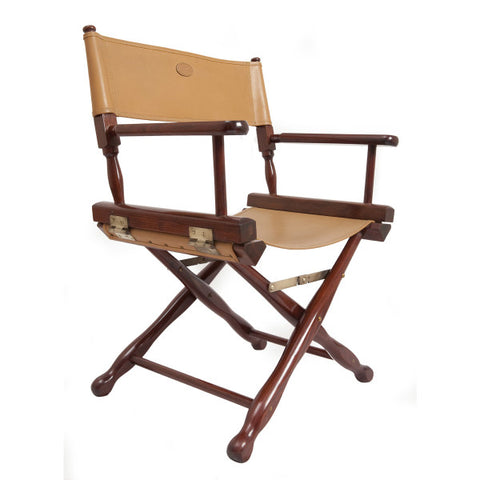
During both wars British troops, among other designs, were using foldable chairs made out of canvas, wood, and metal. They were easy to erect and had a more upright angle compared to the reclined Fenby chairs making them a better choice for performing tasks, such as writing.
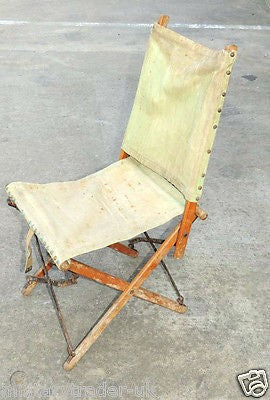
During the World War II plywood folding chairs based on John Cram's design were used in US Air Force's briefing rooms.
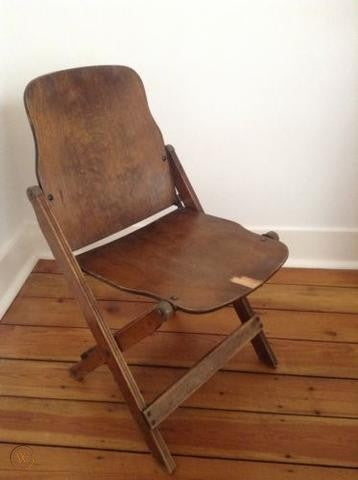
Use of aluminum consumer goods gradually grew after World War II. Most chairs designed for camping were made from polyester canvas and sliding aluminium or steel tubes which are connected by plastic joint parts and rivets. This British army folding chair is the same design that can be purchased in camping shops.
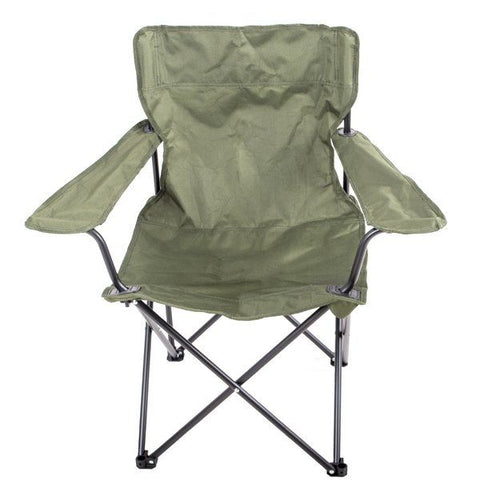
British Army Camping chair
Such chairs are still the most popular camping/garden chair design and are available in almost all outdoor shops. Usually, they are made out of relatively inexpensive parts in high numbers which makes them the cheapest option available- as low as £8 or $10. Carrying them around, however, is less convenient as they is 0.8-1m high when packed. Many traditional-style camping chairs now come with bottle holder pocket or footrest, like this fold-up chair from Relaxdays.co.uk.
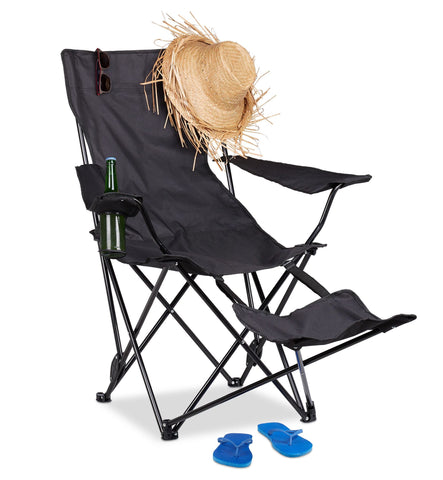
The company that created the first modern lightweight camping chair is DAC, a South Korean company known for its high-end tent poles. Their outdoor furniture and walking poles are sold under the Helinox brand, with Chair One was introduced in 2012. It was made out of the high strength 7000series alloy tubes, 6.6 nylon, and 600D polyester. In 2013 Helinox Chair One won ISPO and Red Dot awards.
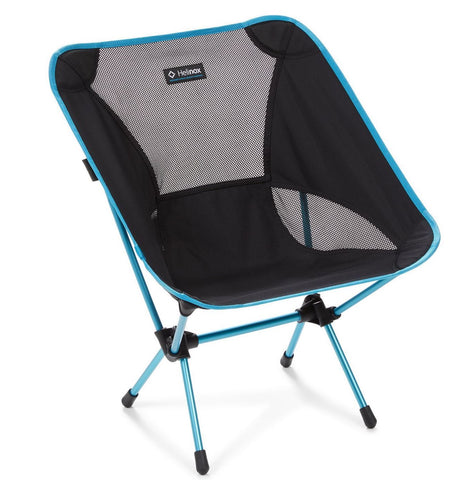
The first version weighed around 0.95 kilograms (2.09lbs) and its packed size was only 0.35m (1.1ft). It was a big leap from the available camping chairs which were bigger both in weight and size by a factor of 2-3. Instead of being a heavy item you carried on your shoulder the camping chair became something you could put into your daypack when you are went to the park, hills, or a beach.
Chair One was created using a combination of principles from the Greek Diphros stool and the Fenby chairs, adapted to suit contemporary materials. It has a central X shaped core to which the legs are attached(Diphros) and the fabric (Fenby). It is the most important outdoor chair design in many decades not only because of its lightweight but also because of superior lower back support. By making the lower back area narrower Helinox designers created a chair that lets you sit with your back straight without effort. The sitting posture of most camping chairs before Chair One was not very ergonomic; most traditional fabrics have a rounded shape meaning that sitter is slouching when relaxed.
After Chair One many outdoor brands soon joined the lightweight chair trend based on the concept of tent-poles. Alite designs, Nigor, REI, Robens, Leki, Big Agnes, MEC, and other companies developed their own versions of camping chairs. Each brand adapted the designs to suit create their own unique versions. Therm-a-rest stood out as the creator of the most unique outdoor chair designs. which had solid carry cases that could be converted into the chair legs.
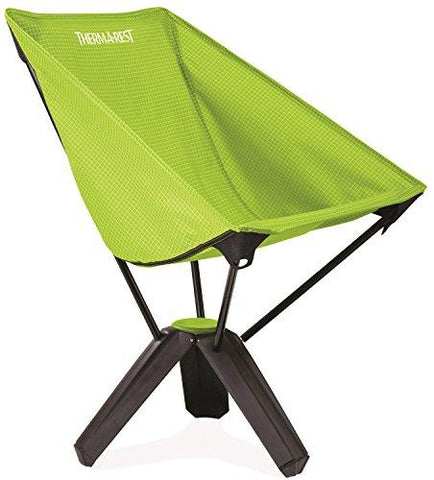
Alite Designs used to create some very reclined chairs as well as rocking chairs (if you have a good sense of balance). Big Agnes and Nigor chairs have wider diameter central studs (instead of plastic hubs used by Helinox) with holes through which legs and back support rods are connected. REI and Leki have created chairs with the central strut perpendicular to the seater.
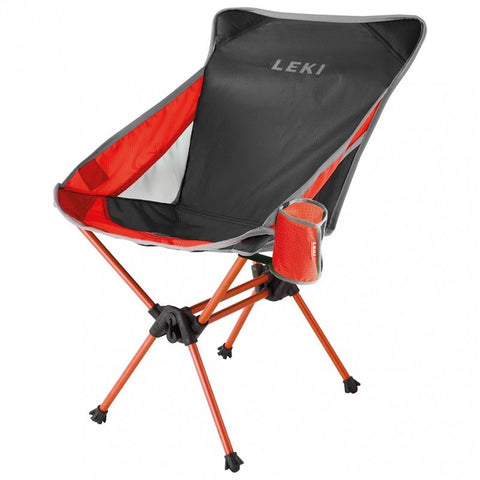
The chair legs in this design are set close together resulting in more tilting sideways on soft ground, particularly for chairs with shorter legs.
These new types of camping chairs have pointy feet that cause them to sink into soft ground. That's no problem if you are camping on hard ground but if you are fishing on a sandy river bank or spending a day on the beach you might find that your chair is not stable enough. Removable Helinox Ball feet are one solution. but they only fit a few Helinox chair models; an alternative crated by Helinox (and copied by many other brands) is Chair Groundsheet.

The groundsheet helps to minimise sinking into a soft ground, like sand or snow but is limited to the distance between the chair legs. Because the pressure points in the corners still remain, they are less suitable for use on lawns or tents.
Our camping chair accessory Chair Buddies can be used as lightweight removable chair feet that pack very small and is compatible with many chair brands. These removable feet have a flat profile that makes them perfect for use on lawns or inside the tents.

There are many lightweight chairs from lesser known brands that can be purchased online. Some of them have increased size chair feet straight out of the box. Some of them, like this Sportneer chair, have adjustable leg lenghts. This increases the chair's weight but it improves its functionality e.g. if you want to use it at a different angle or height.

Currently, the lightweight chairs have a shoulder height range and a high back range. The shoulder height range, which is lighter, constitutes the biggest market share of this kind of camping chairs. The shoulder height chairs do not offer head support. If you like a good afternoon snooze you might want to consider a high back chair, like Robens Observer Chair. These chairs are still light, with most weighing 1.3-1.5kgs (2.8-3.3lbs).

But Helinox is still the market leader in the manufacture of lightweight camping chairs, the lightest one Chair Zero weighing only 488 grams(1.1lb)!
Their Swivel chair gives freedom of sideways movement characteristic to a typical office chair allowing you to turn left and right with impunity.

The Helinox Ground Chair does not have any central core and is designed to be close to the ground. The advantage of such a design is a light weight due to the lesser number of parts.

Another invention by Helinox is their Rocking Feet. You can attach these feet to most camping chairs to turn them into... rocking chairs. Why rock? It helps you to fall asleep faster and reduces stress. Rocking cradles are centuries old method to help those noisy infants to fall asleep.
A couple of years ago Nemo Equipment, an outdoor gear manufacturer known for its innovative designs, created a Stargazer Recliner Luxury Chair. This swinging chair has a sturdy frame with two upright poles, with the fabric part attached to the pole ends. This chair is designed for ultimate relaxation; weighing of 3.2kgs (7lb 2oz) it is a chair designed for car camping or stress-free afternoons in your back yard.

American outdoor retail giant REI stocks GCI Outdoor Road Trip Rocker Chair which uses spring action to create a rocking motion and REI Kingdom Another chair: Rocker Chair has rounded leg shape which enables a rocking action. It is equipped with stoppers if you want to use it in a static position.

Hammock chairs or tree chairs have become more popular in the last decade. Although they look very different from ground placed rocking camping chairs, the main principle: the user's ability to make relaxing back and forth movement, is the same. Such chairs can be hung from tree branches and ceilings, such as this Ivan Hanging Chair sold by Wayfar.co.uk. If you like hanging chairs but the place you want to use them does not have trees or ceilings you can purchase a hammock chair tripod.

Camping chairs with fabric roofs providing shade or protection from the sun and rain have been in the market for some years. Currently one of the most popular brands offering such chairs is Kelsyus. Their Canopy Chair has a built-in shade with an adjustable angle and is very easy to erect. At 5.4kgs (11.9lbs), unless weather conditions are extremely windy, this chair will remain stable.

Early in 2020 Helinox released a Personal Shade that fits most of their camping chairs. This shade has a flat-top profile which is designed to have very low wind resistance. Lightweight low back chairs, on average, weight 0.8-1.2 kg. For such light objects, an overhead fabric shade above can act as a sail. If you leave your chair in even a moderate wind, the whole construction can fly away. This shade does not offer much protection from the later afternoon sun.

Did we mention inflatable furniture? Now we have. Inflatable beds, sofas, and chairs have been available in camping shops for some years, with Vango and Outwell/Easycamp being the two best-known manufacturers. This is furniture that is designed for car camping and use in the back yard. The inflatable chairs are lower than most metal/ fabric chairs and, because of even weight distribution and softness will not damage tent floors. These seats are cheap, with prices starting from £10-£15($13-18).
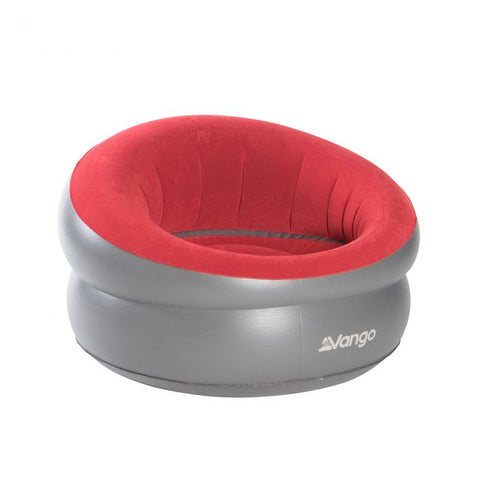
Legless camping chairs are mostly foldable seats with back support. As the name suggests, the legs are absent. Outwell and REI are two best-known manufacturers, with Outwell Cardiel being a cheap and easy-to-use fold-up chair designed for use in campsites, parks and festivals.

More technical legless chairs are the Mountainsmith Slingback Chair and the Therm-a-rest Trekker chair. The Minimalist Slingback Chair weighs only 140grams or 5oz, and consists of a piece of Cordura fabric with two pockets for tent poles. It is often used by minimalist hikers and backpackers: don't leave your walking poles at home!

Therm-a-rest Trekker Chair weighs only 290grams (10.2oz). It is a actually a conversion kit, allowing to convert inflatable mattress into a chair. This is an option specifically designed for backpackers who might have a few evening hours left during their trek to enjoy the luxury of using a chair.
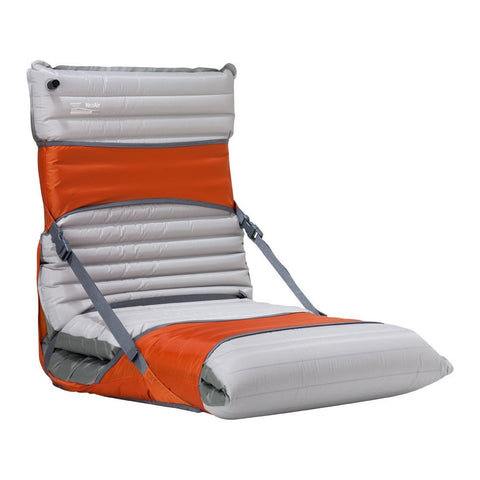
Comparing the two, Trekker is more comfortable than Slingback, you can change the angle of the seat and it will keep you on slightly higher ground. This is especially important during colder months. Slingback chair, however, is much lighter, easier to put together and you are more likely to use it during the day.
The newest camping seat design is the Cliq chair which can be put up in approximately half a minute. It has a spring-loaded mechanism that ensures that all the legs pop out when you are opening the packed chair. All top arms are extendable and are secured by spring-loaded buttons.

Although the Cliq Chair is not heavy (it weighs 1.66kgs or 3.65lbs) it still is slightly heavier than 3 Helinox Zero chairs put together. But the weight is not Cliq Chair's main selling point, which are its small pack size and ease of use. If you like camping equipment which has very low maintenance requirements and takes little space in your car this might be the right chair for you. Since Cliq has bigger feet than most chairs it is less likely to sink into the soft ground.
The Campster chair by Sitpack has the same build principles as the Cliq Chair. They both have similar core part but the Campster has three legs and it is much higher than Cliq Chair.
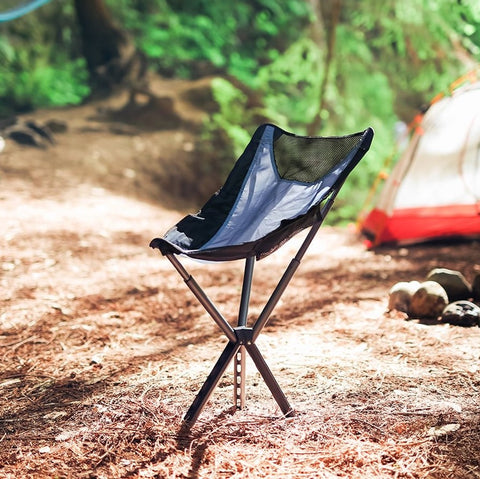
Weighing 0.95kgs, the Campster is 40% lighter but it has shorter back support. This chair will be a great option for use at outdoor events and for general camping. Because of its elevated profile and average feet size, this chair will not be as stable on soft ground, like sand. It is available to buy from autumn 2020.
Conclusion
In the last decade, the range of camping chairs has greatly diversified. Three notable trends are increase of ultralight chair models, as well as proliferation of rocking chairs and chair shades. Lighter and stronger materials have enabled the creation of very lightweight, functional, and comfortable camping furniture.
What is next for the camping chair? Change is the only constant we can predict. Humans are restless creatures. Companies compete and keep innovating. People's desire to use functional, comfortable and lightweight chairs is not going to go away. The camping oracle predicts that there will be more easy-to-pack chair and sunshade designs in the coming years. Let's wait and sit (now and then).

There was one major fault with most of the foldaway chairs in the twenty first century – they were unsuitable for soft ground since the legs would sink down. The modern foldaway furniture is amazing = telescopic stools, foldaway tables, etc., strong, sturdy and practical.
May I ask for advice please. I have what I think are 1940s camping chairs. They are made of Canvas, wood and metal. I could send photos if needed. They are in amazing condition but do not have any markings on them. I have been reaching and came across your website. I would appreciate any guidance. They do look similar to your example n your site. Thank you for your time.
I have a folding camp chair that is made by ALL WIRE WITH
canves to set on and also top lean on ps the wire is all twisted ever you ever seen any thing like thank you CHARLESPHONE NUMBER 541/955/8304 WOULD LIKE TO HERE FROM YOU